| |
Summary:
On
August 28, 2007, Earth's shadow fell across the full Moon producing
a red and turquoise lunar eclipse visible from the Americas (especially
western parts of North America), Hawaii, Australia, New Zealand,
Japan and east Asia. [map]
[animation] [Science@NASA
story] |
 |
| |
| |
Photographer,
Location, Date |
Larger images |
Comments |
|
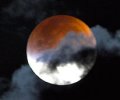
|
Mike
Hollingshead,
Blair, Nebraska, USA
Aug. 28, 2007 |
#1,
#2, #3,
#4, more |
I
did not think it'd be that interesting to photograph without
placing anything in the shot with it. Since I'd never watched
the eclipse start(just parts after it was underway in the
past) I decide to just go out and watch, and take the cam
anyway. These clouds moved in slowly from the west and hung
around, making things a lot more interesting photography-wise.
I wound up shooting several eclipses of the eclipse. Fun
stuff. Camera used was a Canon Rebel XT with a Canon 100-400L
IS. Most shot wide open with an ISO of 800 or 1600 to keep
the shutter under the magic 4 seconds(too blury at 400mm
past that). |
|
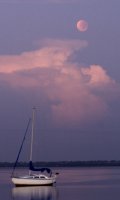
|
Al
Hann,
Crystal Beach, Florida, USA
Aug. 28, 2007 |
#1 |
This
photo was taken from Crystal Beach, FL at 10:34UT (~30min
before local sunrise). The eclipse was _very_ dark at this
point. The extreme relative humidity and haze over the water
made it even more difficult to see/photograph.
Photo
Details: Canon 20D digital camera, 800 ASA, 8sec
@f6.3, 70mm lens (112mm equiv) |
|

|
John
Stephen,
San Jose, California, USA
Aug. 28, 2007 |
#1,
|
The
skies over San Jose were amazingly clear. When I went outside
to setup my equipment the moon was brilliant and only a
few stars were visible, but as totality approached the stars
came out in full force. Photo details: Fujifilm FinePix
S1 Pro, ISO 320, 4s exposure |
|

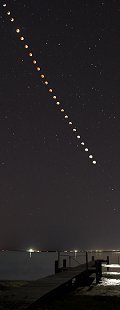
|
Mike
Salway,
Central Coast, NSW Australia
Aug. 28, 2007 |
#1,
#2, #3,
#4, more |
The
partial phases were taken with the 12" newt (dob base) +
32mm eyepiece, with a Canon 300D + 28mm lens, afocal handheld
up to the eyepiece. The totality phase was taken with the
300D + 75-300mm lens @ 300mm, tracked on my EQ6. The images
were resized and combined to make the sequence composite.
I've presented them in a diagonal and horizontal orientation..
simply because I don't know which one I prefer best :) The
widefield static progression sequence was captured with
my 350D + Sigma 17-70mm lens @ 17mm on a fixed tripod. I
had my watch repeating a countdown timer every 7mm to go
and take a shot. Unfortunately the early phases of the eclipse
were clouded out, so the sequence starts further up than
I would've liked. I also ran out of FOV, so I wasn't able
to capture the last parts of the eclipse. The foreground
(water/wharf) was captured with a 20s exposure (ISO200)
which was lit by the low full moon. The stars were captured
with a 25s exposure (ISO1600) just after totality had finished.
The individual moon captures were varying exposures @ ISO200
or ISO400. The images were combined in Photoshop. It's no
Fred Espanek, but it was a learning experience. The last
image is me with my equipment on the night :) Thanks
|
|
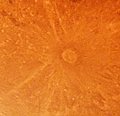
|
Behyar
Bakhshandeh,
Carlsbad, CA
Aug. 28, 2007 |
#1,
#2, more |
Note:
The thumbnail is a close-up of Crater Tycho as it appeared
during the eclipse.
Here
are a couple of images from Aug 28th Lunar eclipse. In the
second picture, I overlaid it over the full moon picture
that was taken earlier in the evening for effect . |
|
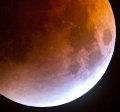
|
Dr
Shinn Yeung,
Brisbane Australia
Aug. 28, 2007 |
#1 |
09:53
UT 28-Aug-2007 Takahashi Sky 90 + Televue 2x Powermate Canon
20D ISO 200 |
|

|
Gilberto
Klar Renner,
Porto Alegre, Rio Grande do Sul, Brasil.
Aug. 28, 2007 |
#1 |
In
Porto Alegre we appreciated only the parcial lunar eclipse.
|
|
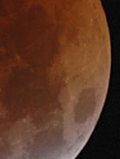
|
Dale
Ireland,
Silverdale, WA. USA
Aug. 28, 2007 |
#1,
#2, #3 |
A
colorful, dark eclipse. Nikon D70, AP130 scope, wideangle
with 55mm lens. |
|
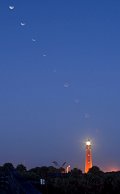
|
Ben
Cooper,
Ponce Inlet, Florida
Aug. 28, 2007 |
#1,
more |
This
relatively obscure sequence, captured on one photo frame
using the multiple exposure technique, shows the moon fade
as it sets behind the Ponce Inlet lighthouse in Central
Florida. It was a much darker eclipse than our last in 2004.
Local smoke and ground fog may have added to that. Hoping
for clear skies this February! |
|

|
Michel
Hersen,
Portland, Oregon
Aug. 28, 2007 |
#1 |
Taken
with a Tele Vue 102 and 40 mm. Scope Tronix Maxview 40 mm.
Eyepiece attached with a Panasonic Bower to a Panasonic
Lumix DMC-FZ8. This shot was taken at 2:49 am using an ISO
of 800 an F of 3.2 and an exposure of 0.77 seconds. Michel
Hersen, Portland, Oregon |
|
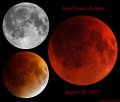
|
Michael
Borman,
Evansville, Indiana, USA
Aug. 28, 2007 |
#1,
more |
This
collage shows three stages of the eclipse - the uneclipsed
Moon from the night before, the partial eclipse, and the
very dark coppery total eclipse. Taken with a Orion 150mm
Maksutov telescope and Canon Rebel XTi DSLR, using a focal
reducer. Exposures ranged from 1/100 sec. for the uneclipsed
full Moon to 30 seconds for the total phase at ASA 400.
|
|
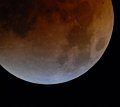
|
Zach
Wagner,
San Ramon, California
Aug. 28, 2007 |
#1,
#2 |
I
have not seen or photographed a total lunar eclipse since
the one in October 2004 and was pleasantly surprised at
the magnitude of this eclipse. The moon became fairly dark
and the colors visible were in a large variety, including
orange, brown, and turquoise. Photo details: Nikon D200
Camera attached to a Meade 8" LX90 GPS; 800 ISO, 2 seconds
exposure. |
|

|
David
Li,
Fuxin, Liaoning, China
Aug. 28, 2007 |
#1,
more |
The
Lunar Eclipses happened when it raised on 28th Aug in east
of China. Maxvison 80ED(480mm/F6) and Canon 30D digital
camera. |
more
images: from
Stan Sammy of Port Dalhousie, Ontario, Canada; from
Novak Ondrej of Sydney, Australia; from
David Hough of Wallsend NSW Australia; from
David Lee of Victoria BC Canada; from
Sherry Buttnor of Metchosin BC CANADA;
|
|
|